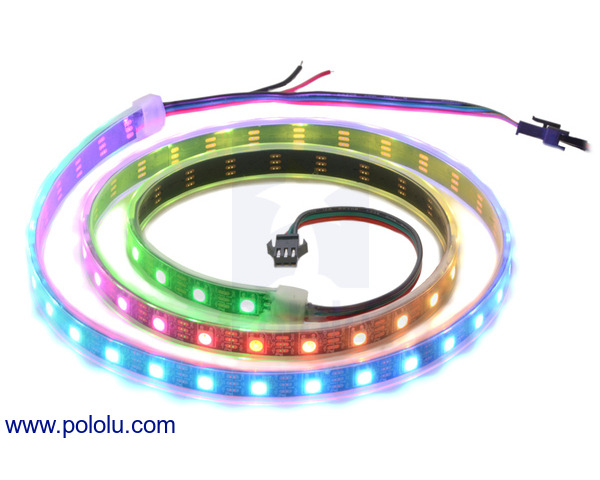Addressable RGB 60-LED Strip, 5V, 1m (WS2812B)
This 1-meter long strip contains 60 RGB LEDs that can be individually addressed using a one-wire interface, allowing you full control over the color of each RGB LED. The flexible, waterproof strip runs on 5 V and can be chained with additional WS2812B strips to form longer runs or cut apart between each LED for shorter sections.
Alternatives available with variations in these parameter(s): length RGB LED density Select variant…
| Description | Specs (7) | Pictures (11) | Resources (7) | FAQs (1) | On the blog (2) | Distributors (0) |
|---|
- How many LEDs can I control? What frame rate can I have?
If you don’t care about the frame/refresh/update rate of your LEDs, there is no theoretical limit on the number of LEDs you can control. If you do care about the frame rate, then you must consider the trade-off between the number of LEDs and the maximum possible frame rate. It takes 30 μs to send the color for a single RGB LED because the color is 24 bits and each bit takes 1.25 μs. Let’s assume that you are using a single microcontroller to control one chain of LEDs (which could consist of multiple strips chained together). If you want a 30 Hz update rate, then you need to update all the LEDs every 33 ms. If it takes 2 ms every frame to calculate the LED colors and to do any other tasks, then there are 31 ms left over for updating LEDs, so you could update a maximum of about 31000/30 = 1033 LEDs. With a lower frame rate, you could control even more LEDs.
Furthermore, we provide example AVR code for AVRs running at 20 MHz that can control three chains of LEDs simultaneously, and it is fast enough to theoretically update 3000 LEDs at about 30 Hz. The actual update rate you get will depend on how long it takes you to calculate all the LED colors. Also, at that point, the RAM size of the AVR becomes an issue because each LED requires 3 bytes of RAM. The Oranguan SVP-1284 has 16 KB of RAM and runs at 20 MHz, so it would be a good choice for controlling large numbers of LEDs.
























